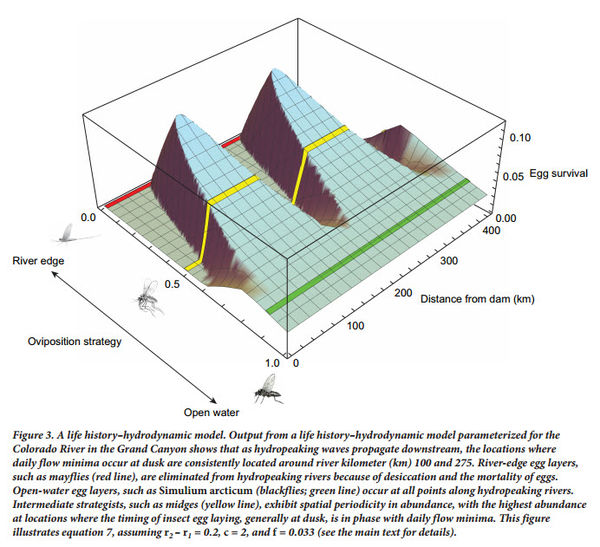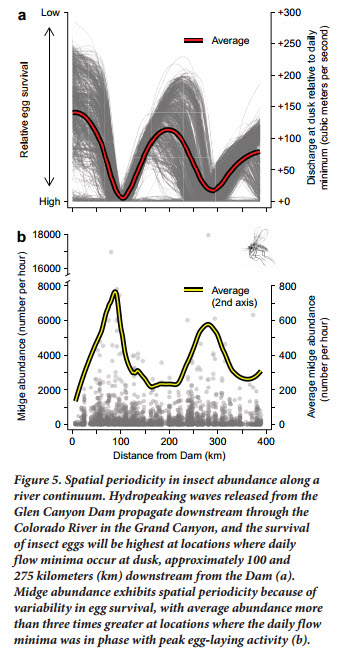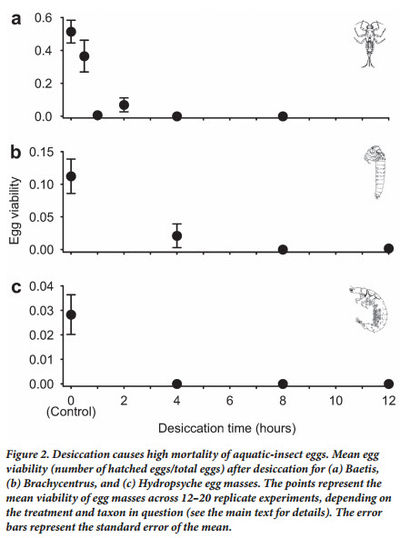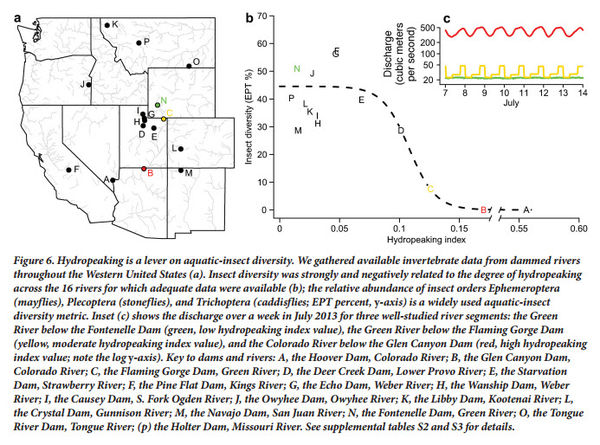Difference between revisions of "'''Oviposition and Egg Desiccation'''"
Cellsworth (Talk | contribs) (Created page with "---- __NOTOC__ __NOEDITSECTION__ <!-- ------------------------------Banner across top of page------------------------------> {| style="width:100%; background:#fcfcfc; margi...") |
Cellsworth (Talk | contribs) |
||
| Line 17: | Line 17: | ||
</table> | </table> | ||
| − | + | [[Media:Kennedy 2016 HydropowerEPT.pdf| '''Kennedy's 2016 Bioscience paper''']] presents a conceptual model describing how hydropower flows could be limiting aquatic insect diversity and production by limiting the reproductive success of insects accustom to laying their eggs along the shoreline. It provides supporting data from an egg desiccation study done below Flaming Gorge Dam, light trap data collected in the Grand Canyon, and a comparison of fluctuation intensity and EPT diversity in several western US hydropower tailwaters. The paper concludes that egg desiccation from fluctuating flows is likely a leading factor in limiting aquatic insect diversity and production in tailwaters below hydropower facilities. The paper also proposes a '''[[The Bugflow Experiment| bugflow experiment]]''' to be tested at Glen Canyon Dam as a possible mitigation for fluctuating flows made for hydropower production. | |
<!-- | <!-- | ||
| Line 41: | Line 41: | ||
|style="color:#000;"| | |style="color:#000;"| | ||
| − | + | [[File:EPThydropeakingModel.jpg|600px]] | |
| + | [[File:MidgeAbundanceFlow.jpg|400px]] | ||
| + | [[File:DesiccationMortality.jpg|400px]] | ||
| + | [[File:EPTdiversityHydropeaking.jpg|600px]] <br> | ||
|} | |} | ||
| Line 59: | Line 62: | ||
*[http://www.usu.edu/buglab/ USU Buglab] | *[http://www.usu.edu/buglab/ USU Buglab] | ||
*[http://www.usu.edu/buglab/Projects/CurrentProjects/#item=123 Macroinvertebrate Oviposition (egg-laying) Habitat Preferences on the Green River below Flaming Gorge Dam] | *[http://www.usu.edu/buglab/Projects/CurrentProjects/#item=123 Macroinvertebrate Oviposition (egg-laying) Habitat Preferences on the Green River below Flaming Gorge Dam] | ||
| − | + | *[http://gcdamp.com/index.php?title=The_Bugflow_Experiment The Bugflow Experiment Page] | |
| − | + | ||
| − | + | ||
| − | + | ||
| − | + | ||
| − | + | ||
| − | + | ||
| − | + | ||
|- | |- | ||
| Line 73: | Line 69: | ||
|style="color:#000;"| | |style="color:#000;"| | ||
| + | '''2016''' | ||
| + | *[[Media:Kennedy 2016 HydropowerEPT.pdf| Kennedy et al. 2016. Flow Management for Hydropower Extirpates Aquatic Insects, Undermining River Food Webs. BioScience]] | ||
|- | |- | ||
Revision as of 13:07, 27 March 2017
|
Kennedy's 2016 Bioscience paper presents a conceptual model describing how hydropower flows could be limiting aquatic insect diversity and production by limiting the reproductive success of insects accustom to laying their eggs along the shoreline. It provides supporting data from an egg desiccation study done below Flaming Gorge Dam, light trap data collected in the Grand Canyon, and a comparison of fluctuation intensity and EPT diversity in several western US hydropower tailwaters. The paper concludes that egg desiccation from fluctuating flows is likely a leading factor in limiting aquatic insect diversity and production in tailwaters below hydropower facilities. The paper also proposes a bugflow experiment to be tested at Glen Canyon Dam as a possible mitigation for fluctuating flows made for hydropower production. |
Oviposition and Egg Desiccation Studies below Flaming Gorge and Glen Canyon Dams |
| -- |
-- |
-- |
|---|
|
|



